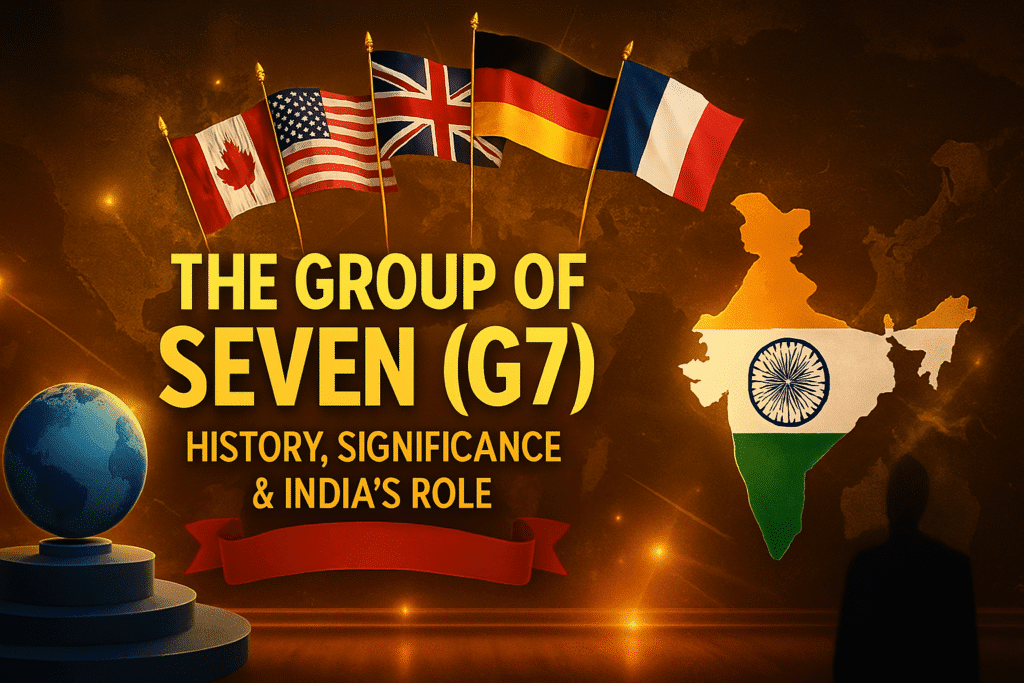
The Group of Seven (G7) is one of the most influential international forums in the world. It brings together the world’s most advanced economies to discuss and coordinate on global issues like economic policy, climate change, security, and development. Although India is not a member, its growing global stature has earned it a regular seat at the table as a guest nation.
This article explores the origin, evolution, structure, and significance of the G7, with a special focus on India’s participation and its implications for global diplomacy and national interest.
Table of Contents
🌐 What is the G7?
The G7 is an informal group of seven advanced economies:
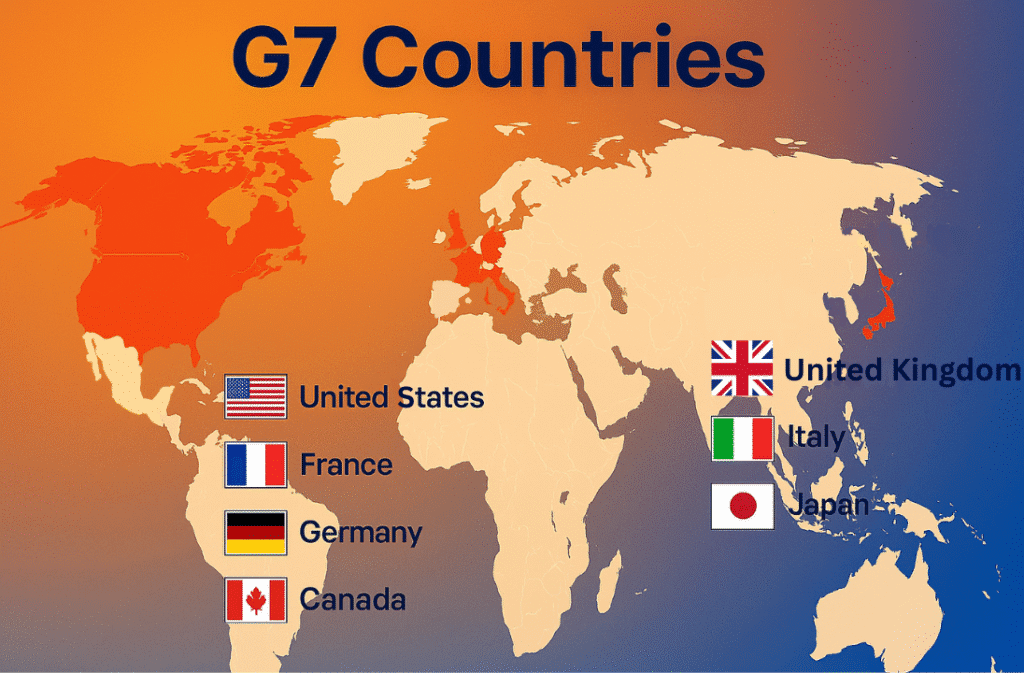
- 🇺🇸 United States
- 🇬🇧 United Kingdom
- 🇫🇷 France
- 🇩🇪 Germany
- 🇮🇹 Italy
- 🇯🇵 Japan
- 🇨🇦 Canada
The European Union (EU) also participates in G7 summits but is not a formal member.
🔍 Key Features:
- No permanent headquarters or secretariat
- No legal binding decisions
- Annual summits hosted by member countries
- Focus on consensus and cooperation
🕰️ Historical Background
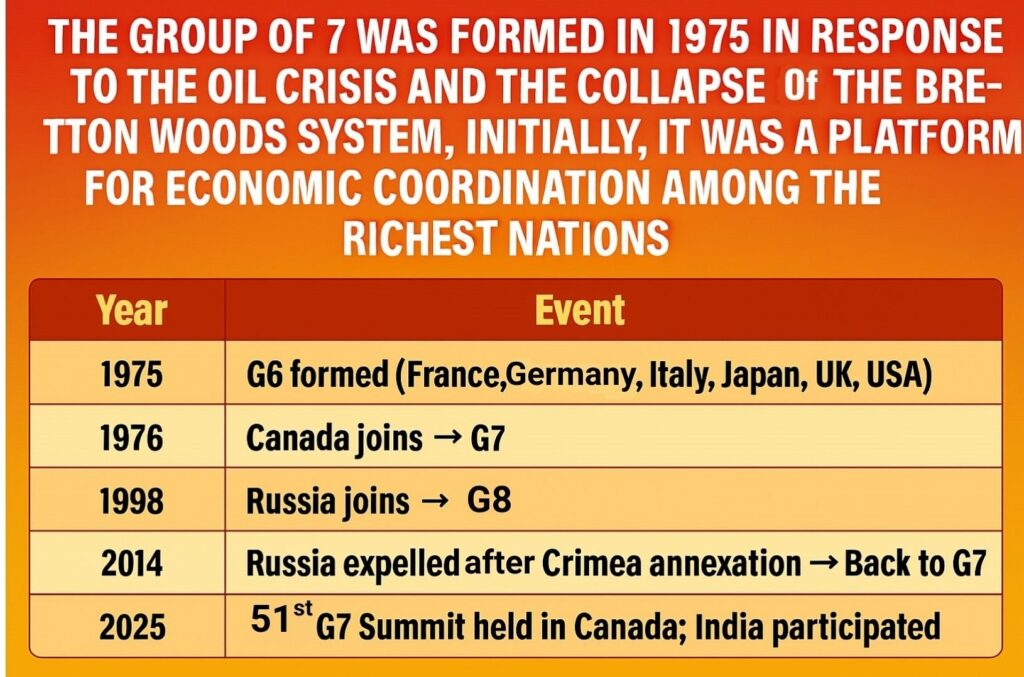
The Group of Seven was formed in 1975 in response to the oil crisis and the collapse of the Bretton Woods system. Initially, it was a platform for economic coordination among the richest nations.
📜 Timeline of Evolution:
| Year | Event |
|---|---|
| 1975 | G6 formed (France, Germany, Italy, Japan, UK, USA) |
| 1976 | Canada joins → G7 |
| 1998 | Russia joins → G8 |
| 2014 | Russia expelled after Crimea annexation → Back to G7 |
| 2025 | 51st G7 Summit held in Canada; India participated as guest |
🎯 Objectives of the G7
The G7’s agenda has expanded from economic issues to a wide range of global challenges.
🔑 Core Objectives:
- Macroeconomic stability and inflation control
- Climate change and green energy transitions
- Global health and pandemic preparedness
- Cybersecurity and digital governance
- Promotion of democracy, gender equality, and human rights
- Support for developing nations through aid and partnerships
🧩 Structure and Functioning
The Group of Seven operates through:
- Annual Summits: Heads of state meet to discuss key issues
- Ministerial Meetings: Finance, health, and foreign ministers meet separately
- Sherpa Track: Senior officials prepare the summit agenda
- Communiqués: Joint declarations issued after each summit
🌱 G7’s Global Influence
Despite being informal, the Group of Seven has a strong impact on global governance.
🌐 Areas of Influence:
- IMF and World Bank policy direction
- Climate finance and carbon neutrality goals
- Digital economy and AI regulation
- Global tax reforms (e.g., minimum corporate tax)
- Humanitarian aid and conflict resolution
The Group of Seven also acts as a policy signaler—its decisions often influence the actions of other international bodies and markets.
📊 Economic and Political Power
- G7 countries represent ~40% of global GDP
- They account for ~10% of the world’s population
- They dominate global trade, technology, and financial systems
- All members are also part of the G20
🇮🇳 India’s Participation in G7 Summits
India is not a member but has been a regular guest since 2019, reflecting its rising global profile.
📅 Timeline of India’s Participation:
| Year | Host Country | India’s Role |
|---|---|---|
| 2005 | UK | PM Manmohan Singh invited |
| 2019 | France | PM Modi attended as guest |
| 2021 | UK | India invited despite COVID-19 |
| 2022 | Germany | India joined climate and energy talks |
| 2023 | Japan | India discussed AI and Indo-Pacific security |
| 2024 | Italy | India participated as an “Outreach Country” |
| 2025 | Canada | PM Modi attended 52nd G7 Summit |
✨ Why India is Invited
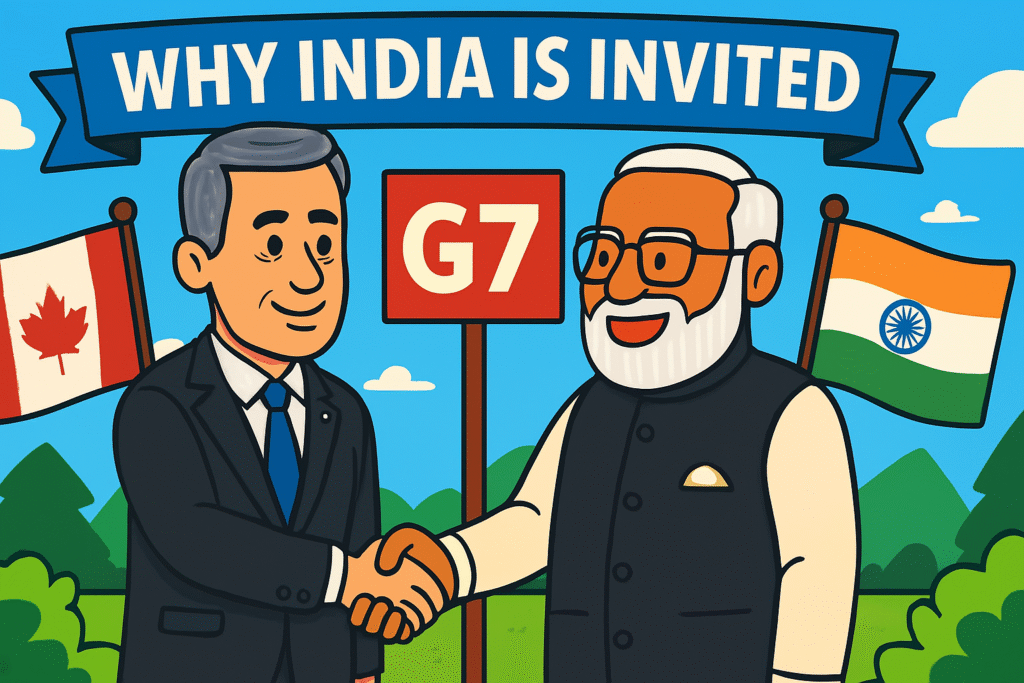
India’s invitations are based on its strategic, economic, and democratic credentials.
🔍 Key Reasons:
- World’s largest democracy
- Fastest-growing major economy
- Key Indo-Pacific player
- Leadership in climate action and digital innovation
- Trusted partner in multilateral forums
India’s participation also helps the Group of Seven engage with the Global South, making its decisions more inclusive.
📌 Importance of G7 for India
1. Global Recognition
Regular invitations signal India’s growing influence in global governance.
2. Strategic Partnerships
India strengthens ties with Western democracies on defense, trade, and technology.
3. Technology & Investment
G7 summits open doors for collaboration in AI, clean energy, and digital infrastructure.
4. Climate Leadership
India showcases its climate initiatives and seeks support for green transitions.
5. Counterbalance to China
G7 cooperation helps India assert its position in the Indo-Pacific and counter Chinese influence.
6. Multilateral Reform Advocacy
India uses the G7 platform to push for UN Security Council reform, WTO restructuring, and fairer global governance.
⚖️ G7 vs G20: A Quick Comparison
| Feature | G7 | G20 |
|---|---|---|
| Members | 7 | 19 countries + EU |
| Focus | Advanced economies | Global economic cooperation |
| Nature | Informal, elite group | Broader, inclusive forum |
| India’s Role | Guest | Permanent member |
🧠 Criticism of the G7
Despite its influence, the Group of Seven faces several criticisms:
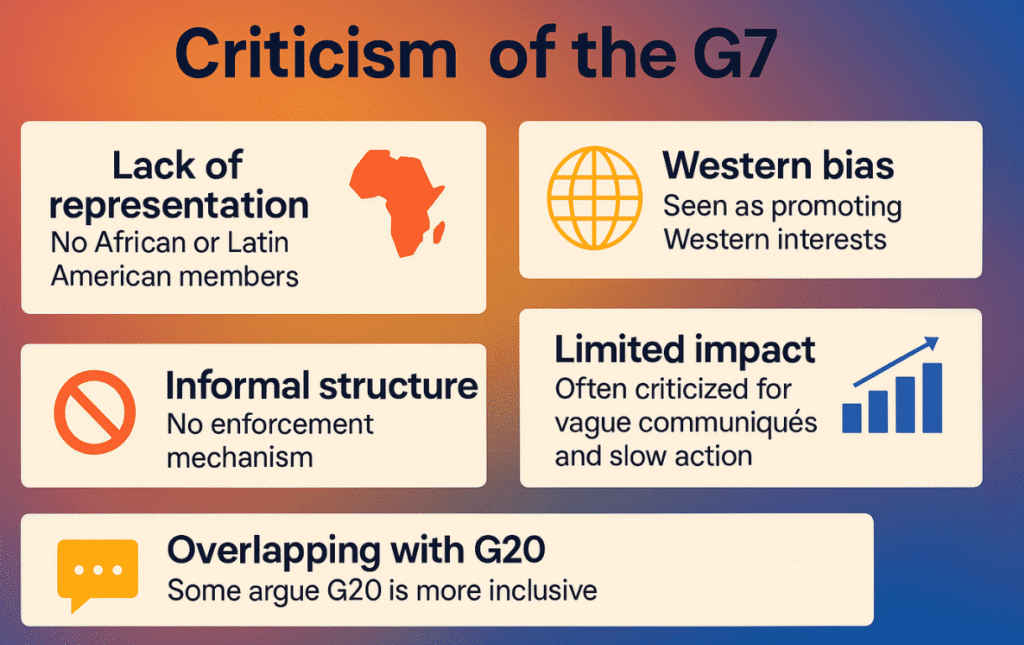
- Lack of representation: No African or Latin American members
- Western bias: Seen as promoting Western interests
- Informal structure: No enforcement mechanism
- Limited impact: Often criticized for vague communiqués and slow action
- Overlapping with G20: Some argue G20 is more inclusive and relevant today
The Group of Seven remains a powerful platform for shaping global policies. While India is not a formal member, its consistent participation as a guest reflects its growing diplomatic clout and strategic importance. For UPSC and PCS aspirants, understanding the G7’s evolution, structure, and India’s role is essential for topics under International Relations, Global Governance, and Current Affairs.
As India continues to rise on the world stage, its engagement with forums like the Group of Seven will only deepen—making it a key player in shaping the future of global diplomacy.
🎨 Static GK
| Country | Capital | Currency | Head of State | Head of Government |
|---|---|---|---|---|
| Canada | Ottawa | Canadian Dollar (CAD) | Governor General Mary Simon (represents King Charles III) | Prime Minister Mark Carney |
| France | Paris | Euro (EUR) | President Emmanuel Macron | Same as Head of State |
| Germany | Berlin | Euro (EUR) | President Frank-Walter Steinmeier | Chancellor Friedrich Merz |
| Italy | Rome | Euro (EUR) | President Sergio Mattarella | Prime Minister Giorgia Meloni |
| Japan | Tokyo | Japanese Yen (JPY) | Emperor Naruhito | Prime Minister Shigeru Ishiba |
| United Kingdom | London | Pound Sterling (GBP) | King Charles III | Prime Minister Keir Starmer |
| United States | Washington, D.C. | US Dollar (USD) | President Donald Trump | Same as Head of State |
Note: The distinction between Head of State and Head of Government is important for polity-based questions in competitive exams. In monarchies and parliamentary republics, these roles are often separate.
🌀 G20: Origin, Structure & Key Facts
| Aspect | Details |
|---|---|
| Full Name | Group of Twenty (G20) |
| Established | 1999 (Finance Ministers & Central Bank Governors) |
| First Leaders’ Summit | 14–15 November 2008, Washington D.C., USA |
| Reason for Formation | Response to 1997–98 Asian Financial Crisis; later elevated post-2008 crisis |
| Members | 19 countries + European Union + African Union (joined 2023) |
| Chairmanship | Rotates annually among members |
| Tracks | Finance Track & Sherpa Track |
| Troika System | Past, Present & Future Presidencies coordinate agenda |
| 2023 Host | India (New Delhi Summit) |
| 2024 Host | Brazil (Rio de Janeiro) |
| 2025 Host | South Africa (Johannesburg) |
| Key Focus Areas | Global economic stability, climate action, digital economy, inclusive growth |
🔹 For more insightful articles and updates on current affairs, feel free to explore our website through this link.
